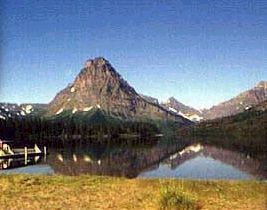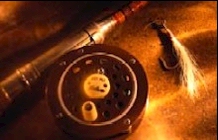|
BLACKFEET INDIAN RESERVATION, Mont. - A
two-foot-long shadow drifts like a ghost toward the tiny egg imitation
that floats at the end of Rachel Schmidt's delicate tippet. Ever so
gently, the shadow sucks the imitation in.
 Schmidt raises her rod tip and sets her
fragile hook, and another giant rainbow trout erupts at the end of her
line.
This is Duck Lake, on the Blackfeet
Indian Reservation near Glacier National Park, and this scene is getting
to be routine. All morning, Schmidt and her companions catch and release
big trout. The smallest of them weighs about four pounds, the largest
are pushing 10. These are deep-bodied fish, obviously well fed, and now
in their vivid spring spawning
colors. Duck Lake is known for the size of its
fish; eight pounds on average. Occasionally, anglers take a 15-pound
brown or rainbow here, and on a typical good day it's not unusual to
hook a 10- or 12-pounder. What makes this place especially out of
the ordinary is that this is not just catch-and-release. This lake is
catch-and-keep, if you choose to keep the fish. Schmidt and the others are here to
demonstrate why the lake is becoming better and better known outside of
Montana; why this tribally managed fishery draws anglers from across the
United States and lures them down from Canada as well.
It is one of the first few days of May,
and ice is beginning to break up here just a few miles south of the
U.S.-Canadian border. Thirty or 40 feet of cold, green water separate
the rocky shore on this part of the lake from the edge of the remaining
ice and, in this open strip, schools of giant trout patrol like
submarines along a coast. Schmidt and her companions, Alex VandeVoort
and Holly Endersby, cast to individual fish.
The Blackfeet Reservation runs south from
the Canadian border along the Rocky Mountain Front, covering some 1.5
million acres. Dave Parsons, a professional outfitter and member of the
Blackfeet Tribe, says it contains about 1,500 miles of rivers and about
20 lakes with fish in them. Duck Lake is the largest, at 1,850 acres.
Schmidt and VandeVoort are guides with
Glacier Anglers, headquartered at West Glacier, on the opposite side of
the Continental Divide. Only members of the Blackfeet Tribe can guide on
reservation waters, so VandeVoort and Schmidt fish here just for fun
whenever they get the chance.
One hooked fish makes a run for the edge
of the ice, seeking to hide beneath its frozen mass and threatening to
break the leader if it's allowed to come in contact with the edge.
Schmidt whips her rod down to one side from 12 o'clock, laying it
parallel to the water at three o'clock, still keeping it tightly bent.
Eventually the fish slows down, and she is able to coax it out from
under the ice.
Parsons wades into the lake alongside
Schmidt, and extends a landing net to corral the tired fish.
The tribe has managed Duck Lake for fish
like this since the 1950s, Parsons says. What makes it different from
other lakes on the reservation?
"Nothing, really," he said.
"It's just a lot more popular. Duck is bigger than other lakes, so
it's a lot better known.
"But there are a lot of lakes here
that are good."
He should know. He has been guiding here
for 17 years, and has had his tribal outfitter's license for 15 years,
doing business as Cut Bank Creek Outfitters and Summit Station Lodge.
Now he employs eight or nine fishing guides, all members of the
Blackfeet Tribe.
Ira Newbreast is director of the
Blackfeet Fish and Wildlife Department, the tribal agency that manages
reservation waters. The trout in Duck Lake are hatchery fish, he said.
"The lake has been stocked since the
early 1900s," Newbreast said. "It still is stocked. It's
managed as a 'put-grow-and-take' lake, because trout cannot spawn in
there."
Rainbow trout require an inlet or outlet
stream in which to spawn, and neither is available at Duck. That
apparently is what the fish are searching for in spring, when groups
cruise along the shoreline like pods of killer whales.
The tribe stocks 80,000 to 120,000 trout
in the lake each year. They go in at 4 to 8 inches, Newbreast said,
depending on how long they're held at the hatchery. The U.S. Fish and
Wildlife Service produces them for the tribe at Creston, near Kalispell.
"They're predominantly
rainbow," Newbreast said. "We stock a few predatory fish -
browns - but we do prefer our native fish, the 'bows, if we can get
them."
The browns are stocked to keep the sucker
numbers down, and that has worked quite well.
Rainbows remain in their quasi-spawning
behavior from ice-out until about mid-June, Newbreast said, during which
they stick close to shore looking for nonexistent inlets and outlets.
After that, they move into deeper water, and anglers must follow.
Besides rainbows and browns, the tribe
stocks west slope cutthroat trout, and also bull trout when it can get
them. The bull trout in Duck Lake may be retained, excluded from
restrictions under the federal Endangered Species Act because they were
surplus to a scientific study, Newbreast said. The cutthroats, browns
and bull trout all provide good fall fishing, he said.
If these are ordinary hatchery fish, what
makes them get so large?
"It's the food," Newbreast
said. "There's just a huge amount of food production in those
(reservation) lakes."
The rainbow in Duck feed heavily on
leeches and freshwater shrimp. So a brown or black maribou leech works
well for fly fishermen, he said. But this lake is not for fly fishing
only.
"It's a 'put-grow-and-take'
lake," Newbreast said."You're restricted from using live fish
for bait, but you can use worms and grubs and grasshoppers and things
like that.
"But, they're really fickle
fish," he said. "You really have to be a fisherman to get into
them. If you don't know how to fish, you can suffer a skunk."
- *In order to fish the Blackfeet Indian Reservation,
an angler must buy a tribal license. Cost to non-members of the
tribe is $60 per year, and includes a boat-authorization sticker and
float-tube-authorization sticker. A one-day license costs $25. A
float-tube sticker is an additional $20, and a boat sticker an
additional $20.
Rewritten with permission
from the Tacoma News
|





